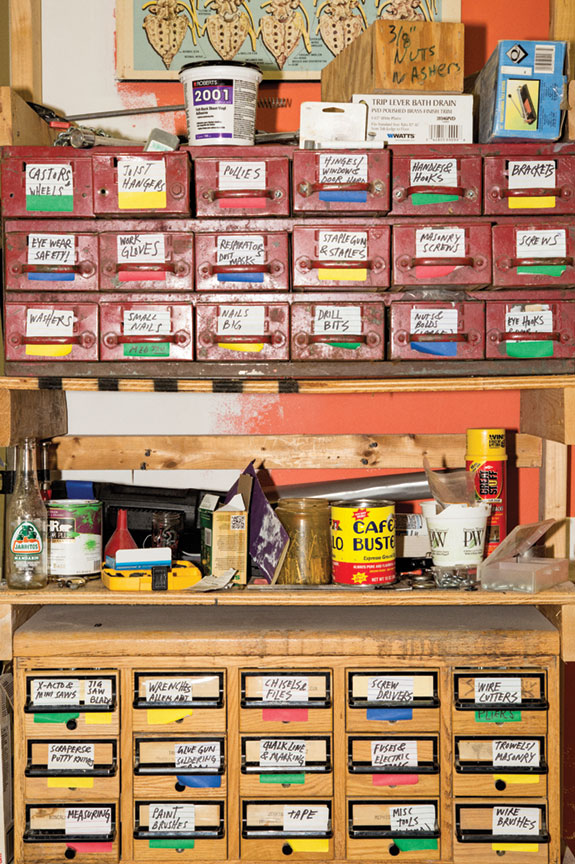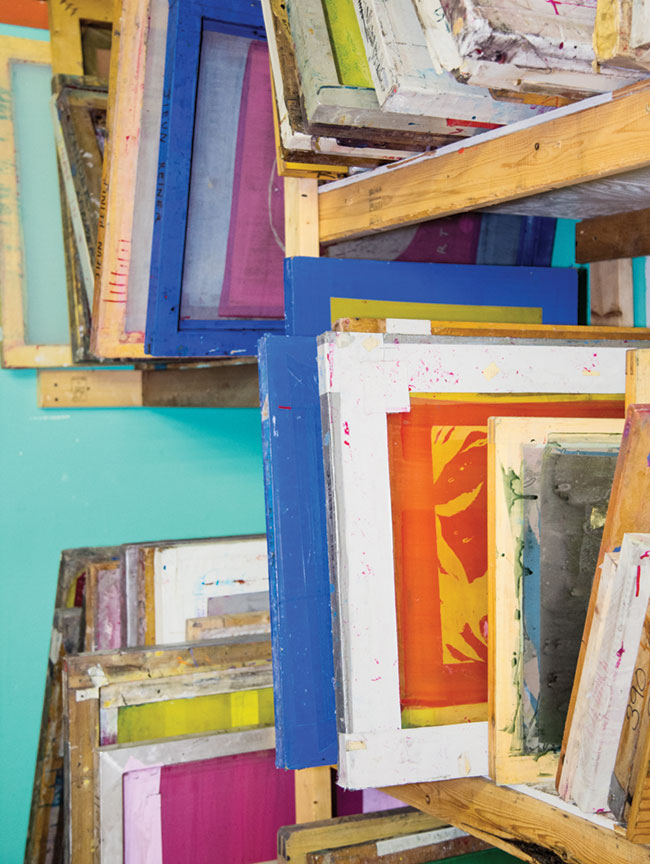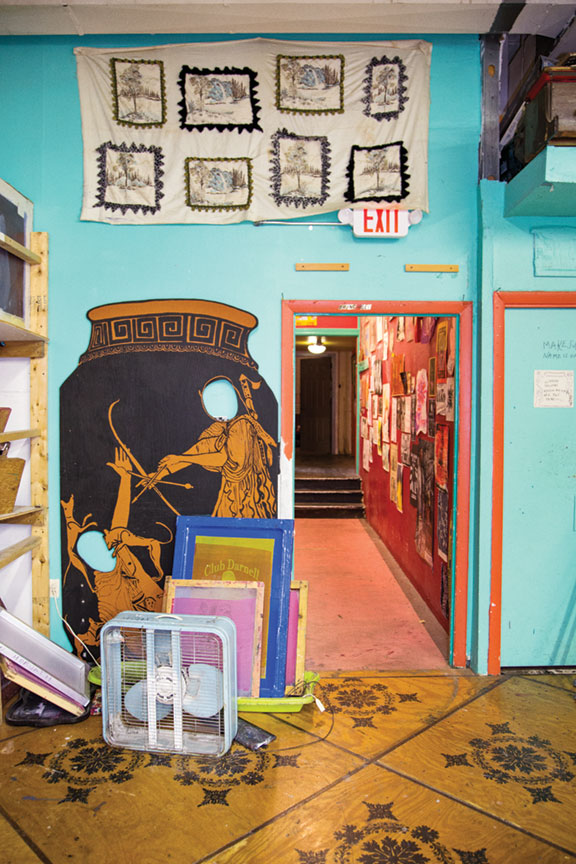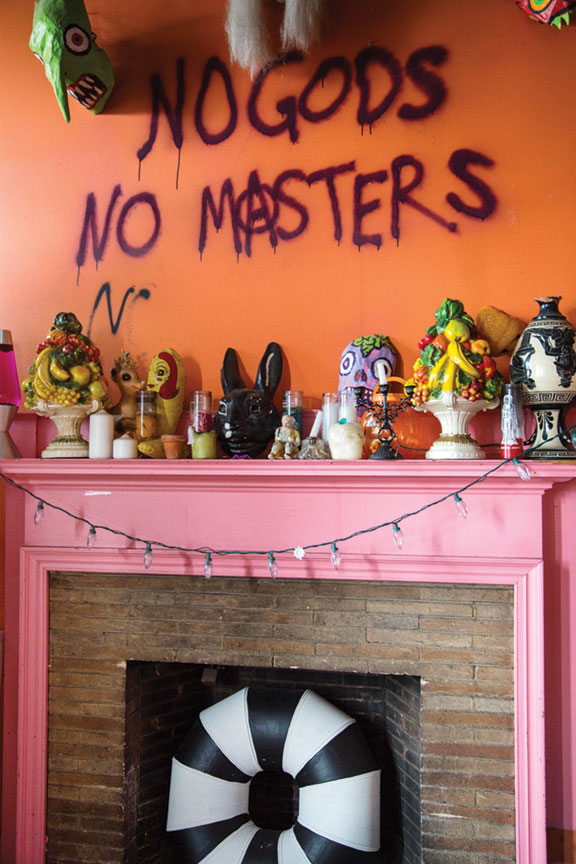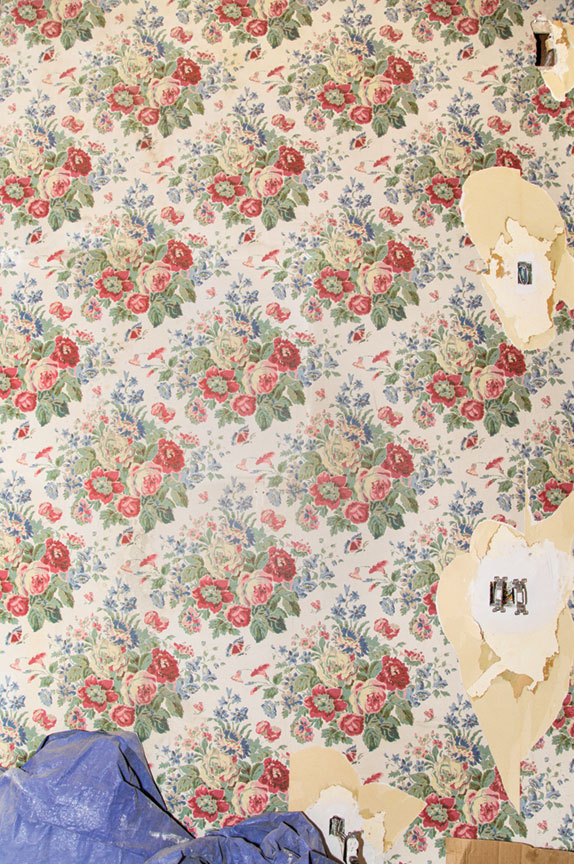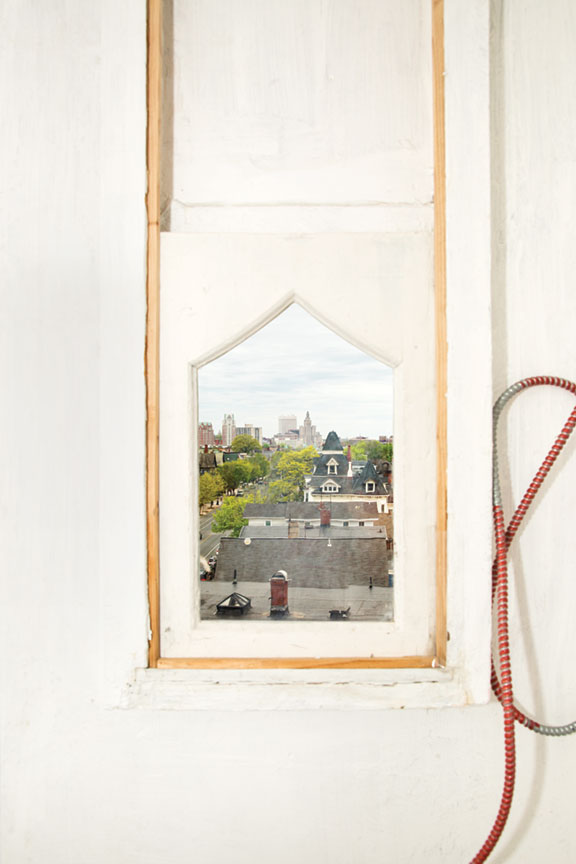DIRT PALACE: An Interview with Xander Marro & Pippi Zornoza
By Faythe Levine
Photos by Amanda Stosz
In honor of their official launch of The Wedding Cake House this weekend in Providence — we’re publishing our interview with founders Xander and Pippi from our seventh print issue (which is now on sale)!
My awe and admiration for Xander Marro and Pippi Zornoza is coming from a shared cultural background rooted in a DIY feminist driven practice. These core values are still perpetuating us all forward into our adult lives. Over the past 15 years our lives have intersected in many cities for various projects and social engagements and it’s safe to say their individual and collective art practices, social engagements and platforms have impacted an uncountable amount of humans. Both of their laundry lists of mediums and accomplishments are of epic proportions, known individually and collaboratively for their different talents, organizing and radical actions. There is truly no succinct way to introduce them, but knowing they exist in this world is not only comforting but empowering.
My relationship with Pippi and Xander starts in the early 2000s with a space they co-founded called The Dirt Palace, a self described “collective that supports women artists by providing affordable studio space, facilities, shared resources, opportunities, a culture of cooperation, and maintains visibility in the community through a committed public arts presence and long term relationships.” The Dirt Palace, located in Providence, RI held a fairytale-esque place in my mind. This was the pre-social media era where underground venues and shows were promoted by flyers, word of mouth and other traveling bands and performers. I had seen some of the work coming out of the space, posters layered with colors and patterns, gold and glitter. Noise music that filled up every inch of my body, and rattled my guts. They were clues of something bigger and I was enamored and under the spell.
My vision of The Dirt Palace being a punk house Villa Villekulla (fictional house that is the home of Pippi Longstocking) filled with women and radical art spilling out the windows wasn’t too far off. Except it wasn’t a house, it was a massive building divided up into individual work spaces, a print shop, darkroom, film editing room, practice space, library, a giant kitchen and communal space, plus the storefront window was utilized as a gallery space. I’m sure I missed something, it was wildly impressive and I was deeply inspired. This was 2008, I went to Rhode Island to interview makers for my documentary Handmade Nation: The Rise of DIY Art, Craft and Design. I had met Xander a few years prior when she was touring her puppet show, Lady Long Arms and Pippi’s noise band, Bone Dust had played in a basement in Milwaukee where I was living at the time.
A little background summary on these two for you to chew on before we move forward:
Xander is a visual artist, filmmaker, produces plays with elaborate sets and costumes. Her work is often about spiritual relationships to the material stuff of this world. Additionally she has a small press project called Demons (DMNS), worked at AS220 serving as the Managing Director and been involved with issues around affordable housing, and equity within the changing landscape of urban America for nearly two decades. She currently serves as the Treasurer of ONE Neighborhood Builders, a Providence community development corporation, and is on Providence’s Art and City Life Commission.
Pippi is an interdisciplinary artist working in sound, performance, installation, video, and printmaking. Zornoza works with themes of horror and violence using samples, triggers, voice, constructed instruments and built environments that transform a grieving body into weaponized sound.
Faythe Levine: I’ve always been so curious how the two of you met.
Xander Marro: I think we met at a meeting as AS220 about low-power fm radio. I thought Pippi had cool fashion, and she recognized me from going to a screening that (another founder) Jo Dery had organized.
Pippi Zornoza: I definitely did not have cool fashion. It was the nineties. It’s shocking to me looking back how bad my fashion was. Have you ever heard of “shpants”? “Jenkos”? Xander is obviously mis-remembering this one. I think I met Xander the day she asked me if I wanted to check out the building that now houses the Dirt Palace–which is pretty remarkable.
Faythe: Can you speak to where and how you see The Dirt Palace fitting in within the local and national art community. Tell us a little more about how it’s run, and what types of programing happens there.
Pippi + Xander: The Olneyville neighborhood is an area that has been home to Providence’s vital music and arts subcultures for over 30 years. The Dirt Palace has grown to serve as a link between DIY, underground and grassroots cultural producers, and the larger world of institutions and arts in Rhode Island. While our feminist mission and approach to self-organization has been at the foreground of our work for the past 18 years, when visitors come to the Dirt Palace they generally leave fixated on the space as an ongoing installation project. Artist-run spaces in Providence have a rich history of intersections between domestic space, work space, and visionary environment. The Dirt Palace is one of the only spaces to have been able to balance this approach with full fire code compliance and longevity. Occupying the sometimes liminal space between a living museum and a functioning legal live/work artist run space, The Dirt Palace has helped to put Providence on the map in terms of big picture art world awareness of the culture in Rhode Island, and brought a feminist twist to the story of Providence’s freewheeling underground that often gets told solely through the lore of exclusively male projects like Forcefield and Fort Thunder.
As the space has aged, we have come often to play the role of model, or folks who people do research with when thinking of starting to do new things. It would also be remiss to talk about our role in the local landscape without talking about AS220, which is kind of the mother-ship of Providence Artist-Run spaces, and at this point a full fledged institution (in a good way). The solid existence, that AS220 provides of an art space where anybody can basically do anything and that is designed for everybody, has allowed a host of other folks to organize creatively around more specific visions and I think the Dirt Palace is part of this. In terms of where we fit in on a national level, well this is more difficult. We had a pretty amazing opportunity through support from the Robert Rauschenberg Foundation to do a strategic plan, which included research on, and site visits to, a number of artist run spaces. From this we found that the cross-section of things that we do was pretty specific. As some background, the things that we do include: maintain a self-organized residency component with a communal structure, present public exhibits, think and talk about feminism and identity, maintain studio/project space and a library, host occasional community events, and connect to a DIY sensibility. We found that most projects did two of these things in combination, and could learn a lot and be inspired by them, but few places embraced any three of the activities that we did. My guess is that this is kind of normal though. Many spaces did a host of other things that we didn’t–art spaces respond to unique conditions connected with local landscape, so it makes a certain amount of sense that their permutation of activities would be unique. We have write ups on our blog about these visits. Projects we met with included: La Central and Studio XX in Montreal, Space Gallery in Portland, ME, IDA and Short Mountain in Tennessee. In NYC we met with Participant, and ABC No Rio, some of the founding members of Colab, and the Editor of the Exit Art Book Alternative New York, and we participated in Common Field and met with a number of arts organizers in that context.
Faythe: The last time I saw you both together was in Tennessee when you came to do the research at IDA and Short Mountain, two rural intentional radical queer communities out by where I was living. I’m so thankful for that memory, partially because you both got to see me living way out in a holler alone in my farmhouse where my closest neighbor was a mile away. What a wild slice of a moment in our lives to cross paths; it feels pivotal in our friendship timeline. I remember we were all crammed around my tiny yellow kitchen table working on various things over morning coffee and you disclosed the then secret possibility of your now very real most recent massive endeavor, the Wedding Cake House. But before we get into that exciting news, let’s talk a little more about the history of the Dirt Palace.
It’s importance as a space grows the longer it lasts. We are seeing our artist run spaces disappear due to rent increase and zoning codes. The stability of what you have fought for and sustained here is so encouraging to me. Do you have a gauge of how many folks have been a part of the project over the years? I just think about communal houses I’ve lived in where things get left behind when people leave. Layers of stuff, both wanted and unwanted. It’s hard to imagine what it’s like to be nearing 20 years in one building filled with often young transient artists (who may tend to accumulate).
Pippi: There’s been about 50 artists/members over the past 18 years. This is significant in regards to the Dirt Palace functioning as this ever changing installation project. The building really serves as a repository for all of the amazing artists who have passed through and left traces behind. The specific media based facilities we have built over time reflect the artists’ interests –textiles, screen printing, wood shop, space to build large things, film/animation. When we first started in 2000 it was at that transition in media where actually everyone but me was a film animator. All of the institutions in Rhode Island were getting rid of their film equipment and we gladly took it.
The space has definitely changed over the years as we’ve gotten older. For one - It’s warm! In the early days, a lot of the struggle was with the physical space. It was cold, and we did all of the buildout over time. However, after years of chipping away, the living space is quite nice, luxurious even. I like to joke that it only took us ten years to get a hot water sink next to the toilet but that illustrates how much the physical space has changed over time. In the early days we transitioned from working on the space every moment that we weren’t working our day jobs, into having one day a month that we would all work on the space together. This is how we got a lot of the bigger projects done–laying a floor downstairs, installing a hot water heater and a tub. Now the work days aren’t so focused on basic needs and we’ve done projects together, such as paint a memorial mural for a member who passed away, or sometimes we do things as whimsical as organizing the spices (because when a space has been around long enough, eventually you have to throw away the 15 year old bay leaves).
Faythe: I totally support the throwing away of the 15 year old bay leaves. And it definitely conjures all sorts of memories of “accidentally” throwing out something in the communal kitchen, like maybe a seemly sour jar of food that was actually someone’s fermentation experiment. Shared fridge maintenance systems is an entirely other conversation. Add it to a future book topic list. Will you both share with us a little of what you are working on now?
Xander: In terms of what I’m doing now… working on this moment of expanding the Project of the Dirt Palace into the Wedding Cake House, both conceptually and from an organizational administrative perspective and physically building out this new space is pretty much beyond a full time existence. And it does feel deeply creative, even though much of the work is like sanding drywall, making spreadsheets, and talking to people. Luckily artists like Merle Ladderman Ukles have come before us and helped to contextualize projects that manage processes of maintenance and repair. So with this stuff on my plate, I’ve scaled back my creative practice which is usually pretty insistent on being decadentally all over the place. and I’ve been really focusing on black and white ink drawings often in conversation with writing (my own and that of others). Sometimes the ink drawings are 3-D because I staple cardboard into a mask form.
Faythe: I absolutely love those paper masks. They were a part of the 2010 show I curated in Brockton, Massachusetts at the Fuller Museum, CounterCraft: Voices of the Indie Craft Community.
Pippi: Like Xander, working on the expansion of the Dirt Palace into the Wedding Cake House is mostly all my brain and body can handle at the moment. As a result, I’ve also scaled back on my creative practice and have been working predominantly in sound (performance and recording). I have several RECTRIX, one of my current music projects, albums in the works. This is pretty exciting for me as usually it takes me about seven years after the fact to release any recordings, and HA! These will only be about 2-3 years in the making.
Faythe: Seven years is an amazing follow through timeline for an album release, and I can’t wait to experience the new albums. I’m currently interested in what my new neighbors think of my varied music choices and you’ll add perfectly into what I’m crafting as the most confusing cacophony of selections. Can you both speak to what it’s like getting older and continue to making radical art spaces and what it’s like to witness that experiences being in the mix. We are all the same general age and it’s pretty far out to end up at shows where I’m absolutely the same age as some of the parents of folks who are performing.
Xander: In terms of how things have changed as the space and we get older. This is a big question, because as we get older, many of the participants have stayed fairly young. Many of the conceptual structures as well as physical realities of the space lend themselves to a younger way of living. Neither Pippi nor I physically live in the space anymore; we have studios there, but after about ten years we wanted to live in quieter situations. I had an early morning job and I lived in the room next to the kitchen. People got home from their bar jobs late–no one was being inconsiderate, but some things became incompatible. I’ve taken twists and turns with the space since then. I wasn’t around as much between 2008 & 2013 when I had very full-time office jobs. Then I finally decided that it was time to freelance, which was a non-stop hustle and was at my studio at the Dirt Palace all of the time, even burning the midnight oil camping out and sleeping there not infrequently. In 2014 we began to think seriously about how we could make things work in a long term sustainable way. This coincided with our work with the Robert Rauschenberg foundation, which allowed us to hire a code consultant and make the space fully legal as a residency. We applied for a grant to do strategic planning work in order to ask hard questions about how the space might be able to live on beyond our participation. There were some serious structural issues around labor, property management and reserves for repairs and capital improvements.
The short answer was that we needed to increase revenue for financial sustainability, but that we also had to grow the project to make it interesting enough to be something for us to personally be willing to devote the rest of our careers to. Stewarding a project that incubates and provides a structure for young women artists to support each other is cool and something that we care about deeply, but for it to occupy so much space in our lives, it needed to grow with us. Ideally that growth would involve widening the band of artist who we’d get to work closely with and support.
Faythe: Lastly I’d just like to hit on the basics with the Wedding Cake House. Can you share the vision, and discuss what’s about to happen there?
“Our mission is to enhance the cultural life of the neighborhood by building relationships between artists and the public as well as creating visibility for female-identified artists and people historically marginalized within the arts. ”
Pippi + Xander: The Dirt Palace at the Wedding Cake House is an ambitious restoration project of the historic 514 Broadway property last occupied by the Tirocchi sisters and the couture design business that they ran from the location from 1915 to 1947. The renovation will develop artist in residence quarters which will complement the feminist residency program and facilities at the Dirt Palace’s current location in Olneyville Square.
Our programing at 514 Broadway will provide support to 20–50 artists per year. Artist residencies serve as research and development laboratories for the arts, providing artists with the critical time, space, and support for the creation of new work and the exploration of new ideas. Rhode Island is home to an incredible community of artists, but has a distinct lack of residency platforms. Our goal of supporting mid-career individual artists through this program addresses realistic challenges in RI’s celebrated arts landscape. The planned expansion of the Dirt Palace artist residency program will address this gap–deepening support for local artists while also inviting rich creative exchange among local, national, and international artists.
Our mission is to enhance the cultural life of the neighborhood by building relationships between artists and the public as well as creating visibility for female-identified artists and people historically marginalized within the arts. The Wedding Cake House project will ground innovation and creative entrepreneurship in a historical context by building out a site that connects the region’s history of design and textile manufacturing to current practices in arts and design fields, while showcasing Rhode Island as a place steeped in design thinking and visionary approaches. Developing a residency program at this site, that connects to the public and is focused on our mission of gender and cultural equity, encourages the arts community to grow in ways that address historical and structural social inequities.
Public programing on this site will complement and support the artist residencies by connecting audiences and artists. Arts patrons will have the opportunity to stay in unique short term rentals alongside of resident artists, allowing for audiences exploring the area to learn about the regional culture and history while directly supporting the creation of new work by our artists in residence. These immersive spaces, filled with local art, will also include audio walking tours, connections to arts programing on site and throughout the city, and will encourage the public to experience both regional history and contemporary art, while intersecting with working artists.
Faythe: I literally just exhaled one of those good deep breaths. I’m so glad y’all exist. I think it goes without saying that the future of your collaborative efforts is on an exciting track. Personally, I am so thankful that I have been able to be inspired and influenced by the work the two of you have done. You are some of my ultimate permission givers of making things happen. I appreciate you both so much, and I hope others feel similarly with this scraping of the surface and look into what you make.
If folks want to look up the various projects of Xander and Pippi:



